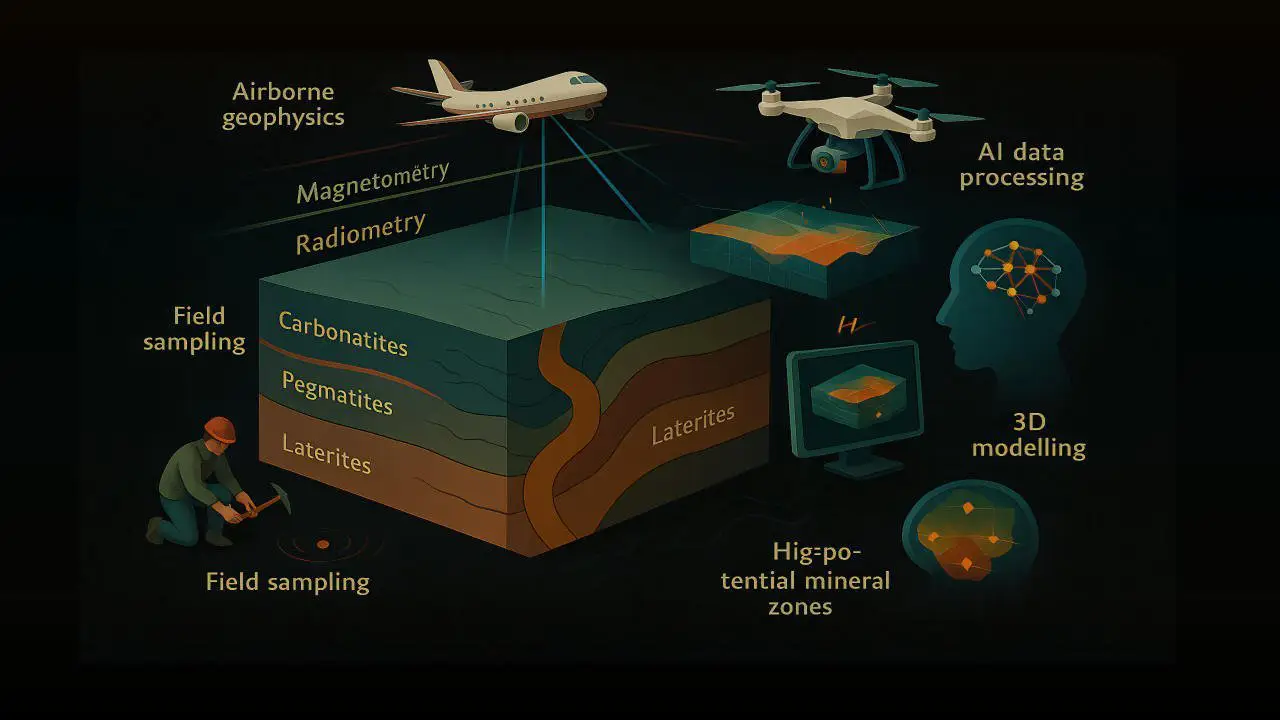Rare Earth Elements (REEs)—a group of 17 elements including the lanthanides, scandium (Sc), and yttrium (Y)—have become indispensable components of modern technology within the energy transition. From smartphones and tablets to electric vehicles, wind turbines, and even defense and aviation equipment, their unique properties, such as magnetic, phosphorescent, and catalytic characteristics, are fundamental for a wide range of industrial and consumer applications. Global demand is rapidly increasing, along with the need to identify new sustainable sources. Geosciences—especially geophysics, geochemistry, petrophysics, and data science—are key pillars in this new exploratory phase.
Although REEs exist in over 250 minerals in the Earth’s crust and are found in a wide variety of geological environments, economically viable deposits are comparatively scarce. The geological nature of REE deposits is varied, including:
Primary Deposits: Associated with igneous and/or hydrothermal processes, such as carbonatites, alkaline rocks, veins, and skarns.
Secondary Deposits: Formed by erosion and weathering processes, such as placers (beach sands), laterites, bauxites, and ion-adsorption clays.
Unconventional or Alternative Resources: Such as ocean floor sediments, ferromanganese crusts, phosphorites, coal, fly ash, mine tailings, and industrial wastes like “red mud” and electronic waste (e-waste).
Applied Geosciences in Exploration
REE exploration requires a deep understanding of their geochemistry, mineralogy, formation processes, and spatial distribution. Modern REE exploration combines traditional techniques with advanced digital tools:
Applied Geophysics: Methods like magnetometry, radiometry, and gravimetry identify physical anomalies associated with mineralized bodies. For instance, in the Fazenda Buriti project (Brazil), integrating magnetometry, radiometry, and Boolean logic defined targets validated by drilling.
Field and Laboratory Geochemistry: Systematic sampling of soils, sediments, and rocks, combined with analyses using ICP-MS, XRF, or portable techniques like pXRF, identifies geochemical anomalies. Using pathfinder elements like Y, Th, and U helps delineate zones with mineralization potential.
Petrophysics: Involves measuring physical properties (such as magnetic susceptibility, density) in rock samples and drill cores. Crucial for understanding the behavior of mineralized rocks and constraining geophysical data interpretation, especially when seeking deeper or covered targets. Allows estimating magnetic mineral content from well log analyses with probabilistic multimineral petrophysical evaluations.
Remote Sensing and Hyperspectral Imaging: Satellite and airborne hyperspectral mapping (e.g., EnMAP) detects spectral signatures of REE-bearing minerals. At Alces Lake (Canada), integrating geophysical and topographic data modeled mineralization control structures.
Predictive Modeling and AI: Artificial intelligence analyzes large geological datasets to generate prospectivity models. In Penco (Chile), Aclara Resources applied machine learning algorithms to reduce exploration areas and focus efforts on critical zones with lower environmental impact.
Statistical and Multivariate Analysis: Used to identify geochemical anomalies, understand element relationships, and map prospectivity.
Boolean and Fuzzy Logic: Combine different predictive maps based on exploration criteria to generate prospectivity maps.
Challenges and Solutions
The sector faces several technical and environmental challenges in REE exploitation, which geosciences help manage:
Depth and Surface Coverage: Many REE deposits lie beneath significant layers of unexploited sediments or rocks, or at great depths in the crust. This hinders detection with conventional methods. Deep-penetration geophysics (low-altitude airborne gravimetry, long-range electromagnetism) and 3D geological models are employed to identify “blind” targets. Additionally, AI can integrate limited data (e.g., shallow drilling) to predict subsurface mineralization extent.
Mineralogical Complexity: REEs are often hosted in complex accessory minerals (monazite, bastnäsite, xenotime, etc.) and accompanied by radioactive elements (Th, U). This assemblage complicates exploitation and requires detailed characterization. Geosciences utilize advanced mineralogy (X-ray diffraction, microprobes) and isotopic geochemistry to understand REE genesis and distribution in host rocks. This knowledge aids in designing more efficient and less polluting beneficiation processes, separating desired elements with less aggressive reagents.
Environmental Impact: REE extraction and processing can generate large volumes of toxic waste. Per ton of REE produced, tens of thousands of cubic meters of acidic gases (hydrofluoric acid, SO₂, H₂SO₄) and tens of thousands of liters of contaminated wastewater are obtained, in addition to radioactive waste. Environmental geosciences develop mitigation plans: monitor water and soil quality, model pollutant dispersion, design engineering works to isolate tailings, and rehabilitate landscapes (e.g., assisted revegetation). They also study alternative techniques like leaching with less toxic solutions and biological treatment of effluents. The goal is to make REE mining more sustainable, with rigorous environmental standards.
Recycling and Circular Economy: Given the high environmental impact of primary mining, there is growing interest in recovering rare earth elements (REE) from secondary sources such as used batteries, electronic devices, and industrial waste. Geoscience contributes by strategically mapping these waste sources and characterizing their composition. Recent projects demonstrate the feasibility of recovering REE from electronic scrap through chemical and physical processes, reducing dependence on new deposits. Research in “urban mining” and selective separation techniques (e.g., bioleaching) is increasingly relevant to closing the loop on these critical elements.
Future Outlook:
Global projections indicate a sustained increase in international demand for REE. By 2030, extraction is expected to be several times higher than current levels to meet the demand for electric vehicle magnets and renewable technologies. In this context, regions with geological potential (such as Latin America, Central Africa, or the Arctic) will receive enhanced exploratory attention. Geopolitically, powers like the U.S., China, and the EU are signing strategic agreements and funding projects (domestic mining and foreign resource acquisition) to secure their supplies. Geosciences will remain at the center of these initiatives, providing objective bases for locating new deposits and assessing reserves.
Simultaneously, technological innovation is expected to continue: high-resolution remote sensing, robotic drilling, real-time geological modeling, and increasingly sophisticated AI algorithms. All of this, along with increased recycling efforts and substitution of uses (e.g., development of magnets with lower neodymium content or without rare earth elements), will shape the sector’s evolution. Ultimately, the sustainable exploration and exploitation of rare earths will critically depend on geoscientific expertise. Only through a deep integration of geophysics, geochemistry, and spatial data analysis can the identification of new deposits be ensured efficiently and with minimal impact. In the new global energy matrix, geosciences constitute the indispensable axis for the strategic development of these critical resources.

